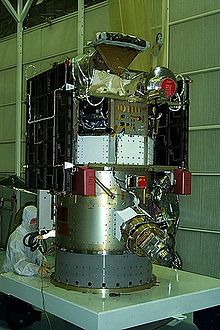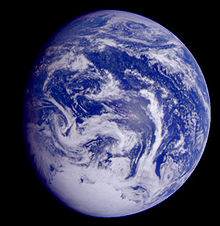- Deep Space Climate Observatory
-
Deep Space Climate Observatory (DSCOVR) (formerly known as Triana) is a NASA satellite proposed in 1998 by then-Vice President Al Gore for the purpose of Earth observation. It is intended to be positioned at the Earth's L1 Lagrangian point, at a distance of 1.5 million kilometers. At this location it will have a continuous view of the Sun-lit side of the Earth.
The satellite's original purpose was to provide a near-continuous view of the entire Earth and make that live image available via the Internet. Gore hoped not only to advance science with these images, but also to raise awareness of the Earth itself, updating the influential The Blue Marble photograph taken by Apollo 17.[1]
In addition to an imaging camera, a radiometer would take the first direct measurements of how much sunlight is reflected and emitted from the whole Earth (albedo). This data could constitute a barometer for the process of global warming. The scientific goals expanded to measure the amount of solar energy reaching Earth, cloud patterns, weather systems, monitor the health of Earth's vegetation, and track the amount of UV light reaching the surface through the ozone layer.
In 1999, NASA's Inspector General reported that "the basic concept of the Triana mission was not peer reviewed", and "Triana's added science may not represent the best expenditure of NASA's limited science funding."[2]
Congress asked the National Academy of Sciences whether the project was worthwhile. The resulting report stated that the mission was "strong and scientifically vital."[3]
Triana was named after Rodrigo de Triana, the first of Columbus's crew to sight land in the Americas. NASA renamed the satellite Deep Space Climate Observatory (DSCOVR), in an attempt to regain support for the project.
Triana was removed from its original launch opportunity on STS-107 (the ill-fated Columbia mission in 2003). The $100 million satellite remained in storage for the duration of the Bush administration. In November 2008 the satellite was removed from storage and began recertification for a possible launch on board a Delta II or a Falcon 9. [4] [5] As of February 2011, the Obama administration is attempting to secure funding to re-purpose the DSCOVR spacecraft as a solar observatory to replace the Aging Advanced Composition Explorer (ACE) spacecraft.[6]
In Al Gore's Our Choice, he uses part of the book as an attempt to revive debate on the DSCOVR payload. The book mentions legislative efforts by Senators Barbara Mikulski and Bill Nelson to try to get the satellite launched.[7]
See also
References
- ^ Leary, Warren (June 1, 1999). "Politics Keeps a Satellite Earthbound". The New York Times. http://www.nytimes.com/1999/06/01/science/politics-keeps-a-satellite-earthbound.html. Retrieved 24 July 2009.
- ^ "Assessment of the Triana Mission, G-99-013, Final Report". Office of Inspector General. NASA. September 10, 1999. http://oig.nasa.gov/old/inspections_assessments/g-99-013.pdf. Retrieved 2009-02-07.
- ^ "NASA's Triana Mission Scientific Evaluation Completed". Earth Observatory: Media Alerts Archive. NASA. March 8, 2000. http://earthobservatory.nasa.gov/Newsroom/MediaAlerts/2000/200003081676.html. Retrieved 2008-02-03.
- ^ "Mothballed satellite sits in warehouse, waits for new life". March 1, 2009. http://spaceflightnow.com/news/n0903/01dscovr/. Retrieved 2009-03-01.
- ^ "NEWS: Triana/DSCOVR Spacecraft Successfully Revived from Mothballs". February 15, 2009. http://lssp.gsfc.nasa.gov/news/about_Triana_DSCOVR_Spacecraft_Successfully_Revived_from_Mothballs.html. Retrieved 2009-09-07.
- ^ "NOAA taps DSCOVR satellite for space weather mission". February 21, 2011. http://spaceflightnow.com/news/n1102/21dscovr/.
- ^ Our Choice
External links
- Vice President Gore challenges NASA to build a new satellite to provide live images of Earth from outer space White House press release, March 13, 1998
- ARL-SCRIPPS Atmospheric Research Laboratory at Scripps Institution of Oceanography
- Deep Space Climate Observatory website at NASA Langley
- NASA DSCOVR NASA Science page
- Review of Scientific Aspects of the NASA Triana Mission National Research Council Report, March 3, 2000
- Politics puts $100 Million Satellite on Ice, The Orlando Sentinel, July 15, 2001
- Scorched Earth Robert L. Park, New York Times, January 15, 2006
- Re-Politicizing Triana, Center for Science and Technology Policy Research, January 15, 2006
- Who Killed The Deep Space Climate Observatory?, Popular Science, April 6, 2011
Categories:- Proposed spacecraft
- Earth observation satellites
Wikimedia Foundation. 2010.


